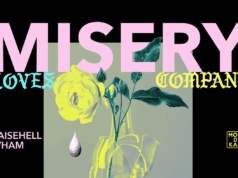Nika Dizon

February 28 — March 16, 2021
Kaida Contemporary
45 Scout Madriñan St., South Triangle, 1103 Quezon City, Philippines
The Ergonomics of our Distractions
Nika Dizon’s first solo exhibition is a play on the senses. It also plays with spaces. But beyond the physical it poses a multiplicity of questions which range from the literal to the things that lie beneath it. Aptly titled Safe Space, the exhibition fleshes out everything that occupies space in a kaleidoscope of colours—from a series of canvas paintings, visceral snapshots of multiple realities frozen in time, to various sculptures laid out as if in offering, beckoning the audience to partake in an invisible feast. On the surface the exhibition is an open invite, a palm outstretched towards the beautiful and the familiar. But amidst the beguiling forms of cake and candy there is also an attempt to mirror our very own collective social condition.
Safe Space pivots around life as we know it within the brazen embrace of late stage capitalism. German economist Werner Sombart first uses this term in the early 20th century, and it is later picked up by Marxian economist Ernest Mandel to refer to the economic period beginning from the end of the Second World War up to the early 1970s, with the evident rise of a post-industrialist society and the steady expansion of commodification. What now arises goes beyond a simple placing of a market price over labour and thought, but also signals the collapse in these creative processes we used to find refuge in. From the largely physical, it begins to move towards a more intimate locality, where personal experiences are weighed on the basis of whether they prove to be valuable in some form or not.
Dizon aphorizes on these events by placing emphasis on their physicality, and the ways in which their design seems to be packaged as a response—or perhaps, a means to cope—from the despondency of our reality. Plaster and resin sculptures are molded into the shape of food—cakes, popsicles, and lollipops—all dipped in alluring colours that entice the sight. Arranged neatly on a large table and inside a glass cabinet, they are within reach but also on blatant display. However, when gazed into, they no longer seem to be as appealing; the image of razor blades and sharp knives come into focus, sharp and dangerous against the backdrop of soft pastels and textured reds.
The commodification not just of leisure and recreation, but also of our basic, fundamental needs remains to be one of the main attributes of late stage capitalism. Almost everything that exists within this complex, evolving spectrum begins to possess an inherent marketplace value, and the status quo is kept secured by ever-tightening societal norms and expectations. The spaces in which we are left to reside have grown smaller and more crowded, packed to the brim with endless means of distractions that manage only to constrict and condense, never to liberate. Ideas and ideals are repackaged, reduced into compact, bite-sized concepts that are then streamlined into an encompassing, uniform whole, devoid of the little idiosyncrasies that mark our collective temperament. Inevitably, we begin to find ourselves amidst absent spaces.
However, the exhibition also takes a more introspective approach by pitting a confrontation between the external spaces we have lost and the inner spaces we occupy. Dizon’s paintings deal with matters that are more personal but also widespread in occurrence, such as trauma, abuse, and the ways we are able to overcome these experiences. In some of the works, the subjects are depicted amidst a myriad of objects, and the imagery, or sensation, of drowning becomes apparent. They float adrift, as if lost and in a daze. There also seems to be a reference to dissociation, or at the very least, in dualities that trauma produces, as seen in the mirror image replica of the subject’s visage in The Compromise, or the splitting of the facial features in Class Picture. The disembodiment of the individual and its silent retreat inwards, as it finds itself lost and misplaced from its external environment, sits at the centre of these works, and Dizon manages to expound on this notion with compelling attentiveness.
But in the end it all returns to one thing: our futile attempts at masking our miserableness by indulging in a plethora of somewhat inane lifestyles. As we continue to live through a society marred by systemic inequalities, and where everything has been commodified for the sole purpose of profit, it becomes more and more evident that there really aren’t any spaces left for us to inhabit. In this respect, the exhibition provokes. It sparks a conversation, or perhaps a gentle suggestion, that despite the hopelessness of the circumstances, we eventually will able to reclaim a little bit of ourselves, piece by piece.
Words by Elle Lucena
For inquiries, please contact the gallery at +639279297129 or at kaida529@yahoo.com.ph.






























